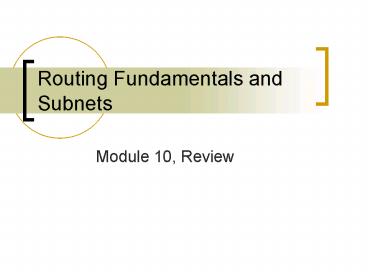Routing Fundamentals and Subnets - PowerPoint PPT Presentation
1 / 19
Title:
Routing Fundamentals and Subnets
Description:
... the Layer 2 frame headers and trailers are removed and replaced at every ... to-live (TTL) A field that specifies the number of hops a packet may travel. ... – PowerPoint PPT presentation
Number of Views:147
Avg rating:3.0/5.0
Title: Routing Fundamentals and Subnets
1
Routing Fundamentals and Subnets
- Module 10, Review
2
10.1.2 IP as a routed protocol
- IP is a connectionless, unreliable, best-effort
delivery protocol.
3
10.1.3 Packet propagation and switching within a
router
- As a packet travels through an internetwork to
its final destination, the Layer 2 frame headers
and trailers are removed and replaced at every
Layer 3 device. This is because Layer 2 data
units, or frames, are for local addressing. Layer
3 data units, or packets, are for end-to-end
addressing.
4
10.1.4 Internet Protocol (IP)
- TCP adds Layer 4, connection-oriented reliability
services to IP. - The MAC address is changed when a frame is
received at a router interface.
5
10.1.5 Anatomy of an IP Packet
- The IP header consists of the following
- Version
- IP header length (HLEN)
- Type-of-service (TOS)
- Total length Identification
- Flags
- Fragment offset.
- Time-to-live (TTL) A field that specifies the
number of hops a packet may travel. This number
is decreased by one as the packet travels through
a router. When the counter reaches zero the
packet is discarded. This prevents packets from
looping endlessly. - Protocol
- Header checksum
- Source address
- Destination address
- Options
- Padding
- Data
6
10.2.1 Routing Overview
- The encapsulation and de-encapsulation process
occurs each time a packet transfers through a
router.
7
10.2.2 Routing versus switching
- Switches use the ARP tables for Layer 2 MAC
addresses and Routers use routing tables for
Layer 3 IP addresses. - Another difference between switched and routed
networks is switched networks do not block
broadcasts. - As a result, switches can be overwhelmed by
broadcast storms. - Routers block LAN broadcasts, so a broadcast
storm only affects the broadcast domain from
which it originated. - Since routers block broadcasts, they also provide
a higher level of security and bandwidth control
than switches
8
10.2.3 Routed versus Routing
- Examples of routed protocols
- The Internet Protocol (IP)
- Novell's Internetwork Packet Exchange (IPX)
- DECnet
- AppleTalk
- Banyan VINES
- Xerox Network Systems (XNS).
9
10.2.3 Routed versus Routing
- A routing protocol functions includes the
following - Provides processes for sharing topological route
information - Allows routers to communicate with other routers
to update and maintain the routing tables - Examples of routing protocols
- Routing Information Protocol (RIP)
- Interior Gateway Routing Protocol (IGRP)
- Open Shortest Path First (OSPF)
- Border Gateway Protocol (BGP)
- Enhanced IGRP (EIGRP).
10
10.2.4 Path determination
- Path determination enables a router to compare
the destination address to the available routes
in its routing table, and to select the best
path.
11
10.2.5 Routing tables
- Routers keep track of the following information
in their routing tables - Protocol type
- Next-hop associations
- Routing metric
- Outbound interfaces
12
10.2.6 Routing Algorithms and Metrics
- The following are the metrics that are most
commonly used by routing protocols - Bandwidth
- Delay
- Load
- Reliability
- Hop count
- Ticks.
- Cost
13
10.2.8 Link State and Distance Vector
- Examples of link-state protocols include Open
Shortest Path First (OSPF) and Intermediate
System-to-Intermediate System (IS-IS). - When a route or link changes, the device that
detected the change creates a link-state
advertisement (LSA) concerning that link. - Link-State refresh packet
- Topology changes
14
10.2.8 Link state and distance vector
- Routing Information Protocol (RIP) The most
common IGP in the Internet, RIP uses hop count as
its only routing metric.
15
10.3.2 Introduction to and Reason for Subnetting
- To create the subnetwork structure, host bits
must be reassigned as network bits. - Benefits of subnetting
- Addressing flexibility for the network
administrator. - Smaller broadcast domains
- Low-level security on the LAN.
16
10.3.2 Introduction to and Reason for Subnetting
- Host bits of the network address are all 0
- Host bits of the broadcast address are all 1
17
10.3.6 Calculating the Resident Subnetwork
through ANDing
- Routers use subnet masks to determine the home
subnetwork for individual nodes. - This process is referred to as logical ANDing.
- ANDing is a binary process by which the router
calculates the subnetwork ID for an incoming
packet.
18
Subnetting Problems
- Applying the default subnet mask for a Class C
network to a Class B network creates 254 usable
subnets. - 16 bits are available for Class B host IP
addresses using the default subnet mask. - What is the subnet mask for the subnets when you
create 5 subnets from a Class C address?
255.255.255.___________?
19
Subnetting Problems
- Given a computer with the IP address of
172.32.65.13 and a default subnet mask what is
the network address of this computers network?































